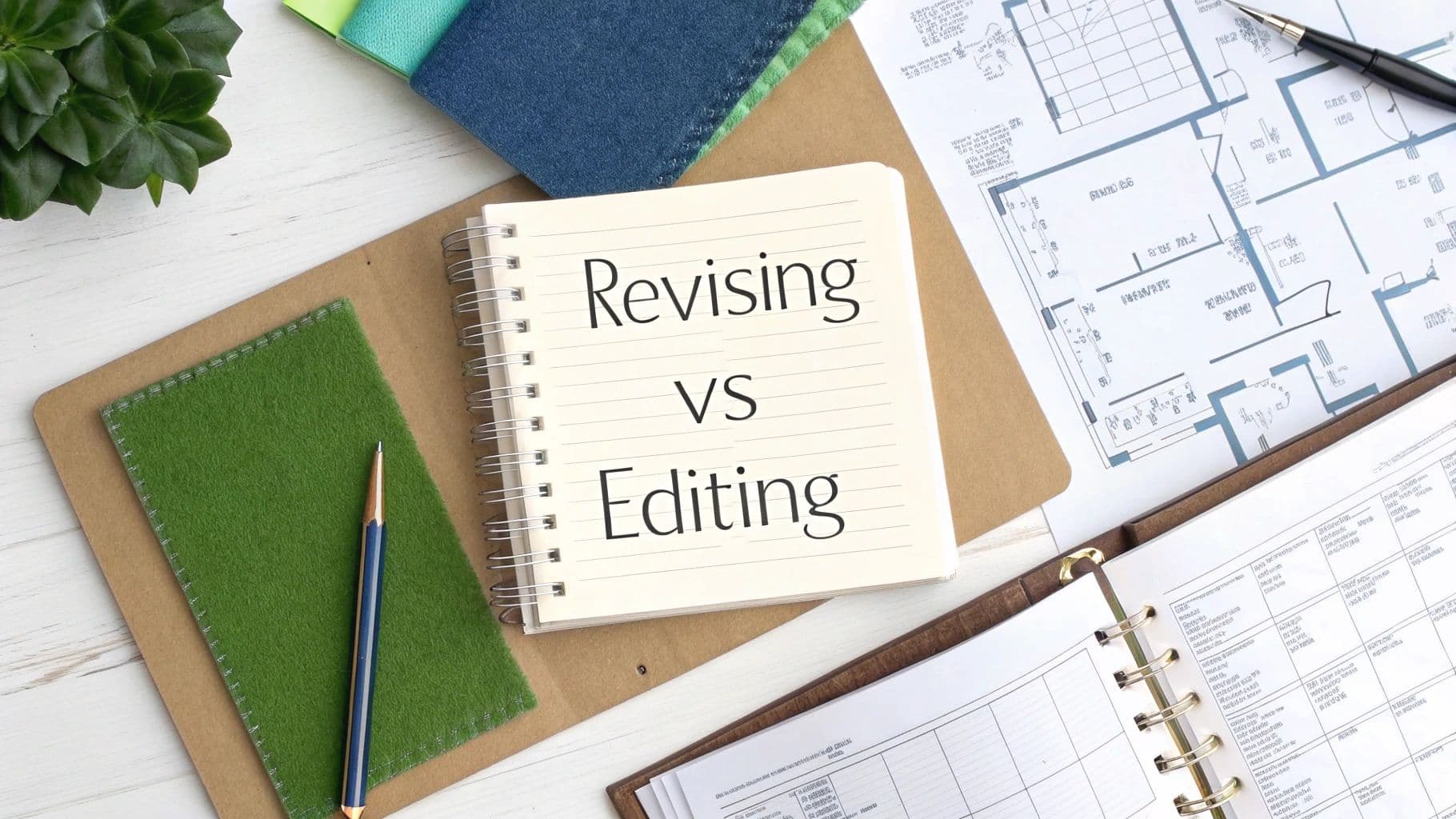
How to Write Research Paper Outline: Tips & Guide
September 21, 2025
Staring at a blank page is one of the most intimidating parts of academic writing. But learning how to write a research paper outline can transform that anxiety into a clear, actionable plan.
Think of it less as a rigid set of rules and more as a strategic blueprint for your argument. It’s the map that guides you from that first spark of an idea all the way to a powerful conclusion.
Why a Great Outline Is Your Secret Weapon

It’s easy to dismiss outlining as just another box to check, but I'd argue it’s the single most important part of the entire writing process. It’s like an architect’s drawing for a building—without one, you’re just guessing where the walls and windows should go.
A solid outline gives you a clear path forward. It forces you to organize your thoughts, line up your evidence, and build a logical case before you ever start writing full paragraphs.
This simple tool does more than just keep your ideas tidy. It also:
- Beats writer's block by breaking a huge project into small, manageable chunks.
- Creates a logical flow by making you sequence your points in a way that builds a persuasive argument.
- Saves a ton of time during revisions because your core structure is already sound.
The Power of Planning
The difference between a frantic, last-minute scramble and a smooth, methodical writing process usually comes down to the quality of your plan. The data backs this up, too—students who create detailed outlines can boost their writing efficiency by up to 40%.
In fact, a staggering 75% of common academic writing struggles can be traced back to poor planning and a weak structure. When your foundation is solid, everything else falls into place much more easily.
"An outline is not a cage, but a key. It unlocks your ideas and gives them the structure they need to be powerful and persuasive."
Ultimately, the time you put into a good outline is a direct investment in the quality of your final paper. It’s a foundational step that makes the whole journey smoother, a key principle of https://naturalwrite.com/blog/better-academic-writing.
For even more ways to sharpen your process, these comprehensive research paper writing tips offer some great advice on everything from initial planning to the final polish.
Setting the Stage Before You Start Outlining

A powerful research paper outline isn’t something you create in a vacuum. I’ve seen it time and time again—the most effective outlines are built on a solid foundation of preliminary work. This prep turns a simple structure into a strategic roadmap for your entire argument.
Rushing this stage is a classic mistake. Before you even think about Roman numerals or bullet points, you need a firm grip on your core message and the evidence you'll use to back it up. If you skip this, you'll end up with a disconnected, confusing outline later. Trust me.
From Research Question to Thesis
Your first real task is to sharpen your initial research question into a clear, debatable thesis statement. Think of the thesis as the destination on your map; every single point in your outline must lead directly back to it.
A weak thesis leads to a weak paper. For instance, a statement like, "Climate change has many effects," is just a fact, not an argument. It goes nowhere.
A much stronger thesis would be something like, "The primary driver of modern climate change is industrial carbon emissions, which disproportionately damage the economies of developing nations." See the difference? This gives your paper a specific direction and a real purpose.
Once that thesis feels solid, it's time to organize your evidence. Sift through your notes, articles, and data, and start grouping things by common themes and supporting arguments. This is where you connect the dots between your research and your main point.
A great way to get this structured is by completing a thorough review of existing studies. If you need some pointers on that, check out our guide on how to write a literature review.
A great outline doesn't just list topics; it organizes a conversation. It's the silent rehearsal of your argument, ensuring every piece of evidence has its moment to speak and support your thesis.
Getting this prep work done ensures that when you finally start structuring your outline, you aren't just filling in a template. You're strategically arranging the building blocks of a persuasive and coherent research paper.
Building Your Outline for Logical Flow
Once you have a solid thesis and your research is sorted, it's time to build the actual structure. This is where the classic alphanumeric outline (I, A, 1, a) becomes your best friend. It’s way more than a formatting quirk—it’s a powerful tool for creating a logical cascade where every idea directly supports the one above it.
The beauty of this system is its built-in logic check. A sub-point under "A" must directly prove or explain "A," which in turn has to support the main argument "I." If a point doesn't fit neatly into this nested structure, it’s a huge red flag. It either belongs somewhere else or, just as likely, it doesn't really contribute to your main argument at all.
This infographic lays out the typical flow for organizing the main sections.

You can see how each major part of a research paper builds on the last, creating a coherent story from introduction to discussion.
Creating a Persuasive Cascade
Let’s walk through a practical example from environmental science. Imagine your main section (Roman numeral II) is "The Impact of Urban Heat Islands on Local Biodiversity." Your outline shouldn't be a random list of facts. Instead, you need to build a structured argument.
- A. Increased Temperatures Create Unsuitable Habitats
- Evidence from a 2021 study showing a 5°C average temperature difference.
- Analysis of how this affects native plant species' reproductive cycles.
- B. Altered Water Cycles Reduce Viable Ecosystems
- Data on increased surface runoff and decreased soil moisture in urban cores.
- Example of local amphibian populations declining due to loss of damp environments.
See how each point (1, 2) offers specific proof for the claims in A and B? This method transforms a simple list into a compelling, evidence-based argument that’s easy for your reader to follow. For more on structuring your core arguments, check out our guide on thesis statement examples.
This hierarchical approach isn't new. The Outline Method has been a cornerstone of formal education since the 1920s, precisely because it forces clarity and logical progression. In fact, one 2018 survey found that 85% of university instructors prefer students to submit a detailed outline before writing, believing it significantly strengthens the final paper's argument.
The goal isn't just to list your points; it's to arrange them in a way that makes your conclusion feel inevitable. A well-structured outline builds momentum, guiding the reader through your logic step by step.
Ultimately, breaking down big ideas into smaller, supporting pieces is what gives your paper its persuasive power. It makes the final writing stage feel more like assembling a puzzle than staring at a blank page.
Mapping Out Each Part of Your Paper

A truly effective research paper outline is more than just a list of topics. Think of it as a miniature version of your final paper—a detailed map that guides your argument from the very first sentence to the last. Each section deserves its own dedicated space within this map.
Let’s start with the introduction. This is where you grab your reader's attention and set the stage. Your outline for this section needs to pinpoint your opening hook, the essential background context they'll need, and most importantly, your crystal-clear thesis statement.
This isn't about just wandering into your topic; it's about entering with a clear purpose that orients the reader immediately. A well-planned introduction makes the rest of the paper far more compelling.
Plotting the Body Paragraphs
The body of your paper is where you build your case, brick by brick. When you're learning how to write a research paper outline, this is where the heaviest lifting happens. The key is to assign one major argument or theme to each of your main points.
Then, under each of those main points, you’ll create sub-points for the specific evidence that backs it up. A solid structure might look something like this:
- Evidence: Jot down the specific data point, statistic, or study you plan to cite.
- Expert Quote: Plan where you’ll drop in a quote to add authority to your claim.
- Your Analysis: Briefly describe how you’ll interpret this evidence to support your thesis.
This methodical approach keeps you from just dropping facts into your paper without context. It forces you to connect every single piece of evidence back to your central argument, creating a tight, persuasive narrative.
An outline isn't just about what you're going to say; it's about how you're going to prove it. Each sub-point in your body section should be a direct answer to the question, "How do I know this is true?"
Framing a Strong Conclusion
Finally, your outline has to tackle the conclusion. Don't treat this as an afterthought. A powerful conclusion reinforces your entire argument and leaves a lasting impression on your reader. It's the final move that ties everything together.
Your conclusion outline should plan for three key things: a restatement of your thesis (using fresh words), a quick summary of your main findings, and a final thought on the broader implications of your work. This structure ensures you end on a strong, memorable note instead of just trailing off.
Picking the Right Tools to Nail Your Outline
You don't have to wrestle with your research paper outline using just a plain old word processor. The right digital tools can make the whole process feel more alive and intuitive, helping you spot connections you might have otherwise missed.
If you’re a visual thinker, mind-mapping apps like Miro can be a game-changer. These platforms are like a digital whiteboard, letting you brainstorm ideas freely and then draw lines between concepts. It’s a great way to build an organic structure before you ever try to force it into a linear format.
Finding Your Go-To Outlining Software
For those who crave a bit more structure, some dedicated writing software can be incredibly powerful.
- Scrivener: There's a reason so many academics swear by this tool. It lets you break your paper down into small, manageable chunks—think of them as digital index cards—that you can drag, drop, and rearrange as your argument takes shape.
- Google Docs & Microsoft Word: Don’t sleep on the tools you already know. Both have surprisingly solid outlining features built right in. Just by using heading styles, you can create a collapsible, clickable document map that makes navigating your draft a breeze.
Of course, you're not limited to dedicated writing software. All-in-one productivity platforms can also be fantastic for this. For instance, exploring something like Notion as an ultimate guide for students can open up new, flexible ways to manage your academic work, starting with the crucial first step of outlining.
The right tool does more than just organize your thoughts—it helps you think better. It gives you a flexible space to build, test, and refine your argument until it's rock-solid.
In fact, the data backs this up. Research shows that using guided outline tools can boost paper completion rates by about 60%. What's more, students who use these methods are 45% less likely to forget key components in their final papers. You can read the full research about these educational platform findings to see just how much of a difference a systematic approach makes.
Questions That Pop Up During Outlining
Even the most seasoned academics hit a few snags when outlining. Let's walk through some of the common questions I hear, because clearing these hurdles early makes the whole process smoother.
The biggest one is always about detail. How much is too much? A good rule of thumb is to aim for enough detail that each point in your outline could comfortably expand into its own paragraph.
That means jotting down your main arguments, the specific evidence you'll use to back them up, and even a quick note on how you'll connect one idea to the next. Trust me, a detailed outline saves you a ton of time and headaches later. If you find yourself staring at a blank page, it's almost always a sign that a part of your outline needs a bit more flesh on its bones.
What if My Argument Changes While I Write?
This happens. And honestly, it’s a good thing. It means you’re really digging into your research and thinking critically about your topic. Your outline is a roadmap, not a cage.
Think of your outline as a GPS; if you hit a roadblock, you just find a new route. Don't be afraid to go back, tweak a few sections, shuffle your points, and make sure the new structure still logically flows from your thesis.
Am I Stuck With the Alphanumeric Format?
While the classic alphanumeric outline is the gold standard for a reason—it’s clean and logical—it's definitely not your only option, especially in the early stages.
- Mind Mapping: When you're just trying to get ideas out, a mind map is fantastic for seeing how concepts connect without being boxed in by a rigid structure.
- Decimal Outlining: In some technical or scientific fields, you’ll see a decimal system (1.0, 1.1, 1.1.1). It's incredibly clear for handling topics with many complex layers.
The point is to find a system that helps you think clearly. When it's time to create the final plan you'll write from, the alphanumeric format is usually the most effective and universally understood.
Ready to turn that perfectly structured outline into a polished, natural-sounding paper? Natural Write can help humanize your text, making sure it’s clear, readable, and avoids that robotic AI feel with just one click. Refine your research paper effortlessly at https://naturalwrite.com.


